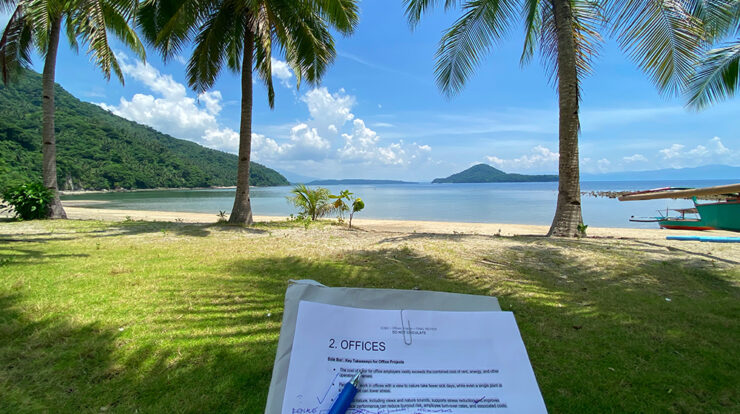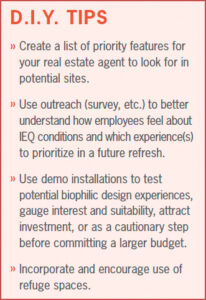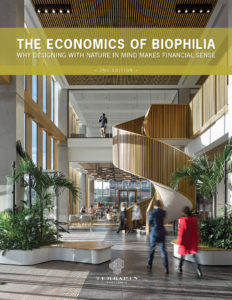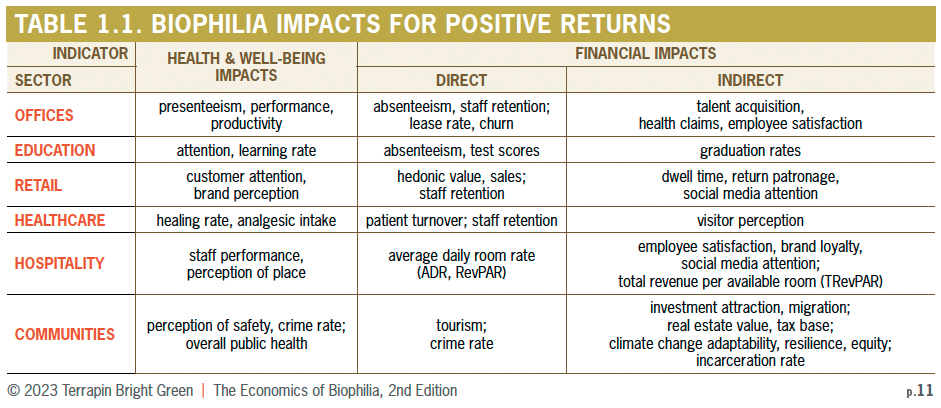

News
It’s finally here! The Economics of Biophilia, 2nd edition
Catie Ryan
Share
The long-time coming second edition of The Economics of Biophilia is finally here for us all to geek out on! Through support from Interface, we at Terrapin are very excited to release this new report. In 2012, we set out to share with the industry the great potential of biophilic design. We sought to provide evidence for how to improve both occupant health and the building’s bottom line. The first edition of The Economics of Biophilia (EOB) was an immediate hit and the Environmental Design Research Association (EDRA) recognized EOB with the 2014 Accomplishment Award. Many architects often tell us that they use EOB to communicate potential economic benefits to project owners and clients. Others say they use EOB to identify ways to differentiate their project from market competitors.
This second edition (EOB2) saves the best of what worked in the first edition and weaves in dozens of new scientific research, 14 case studies, and fresh perspectives, as well as:
- Foreword by Rick Fedrizzi, Executive Chairman of the International WELL Building Institute (pg.3)
- Table of Biophilia Impacts for Positive Returns: indicators supporting positive returns on health and financials (pg.11)
- Primer on Biophilia: good for newcomers to biophilia and for those looking to brush up on the facts (pp.13–17)
For offices, education, retail, hospitality, healthcare, and communities—each a sector specific chapter—we’ve included the following:
- Key Takeaways: highlighting notable speaking points extracted from the research

- Research and financial perspectives: translating the science into sector specific metrics, indicators, and financial extrapolations
- Theory to Practice narratives: what’s going on now as market trends in implementation
- Case studies: 2–3 examples from the field and, where available, including financial data
- Future Directions for Research and Reporting: what Terrapin has identified as key research questions or priorities
- Do-it-yourself tips: Actions that can be taken with minimal or no external investment
Terrapin’s effort to help close the typically long time gap from research to application continues with EOB2—a resource of science translated into practical, relatable, and actionable evidence-based solutions. We hope you enjoy reading it as much as we enjoyed writing it.
Read more and download your free copy of The Economics of Biophilia, 2nd edition.
Filed under:
Catie Ryan
Catie is the Director of Projects at Terrapin and a leader in biophilic design movement. With a background in urban green infrastructure, Catie's interest lies in systems thinking to address human health and sustainability challenges at each scale of the built environment.
Topics
- Environmental Values
- Speaking
- LEED
- Terrapin Team
- Phoebe
- Community Development
- Greenbuild
- Technology
- Biophilic Design Interactive
- Catie Ryan
- Spanish
- Hebrew
- French
- Portuguese
- Publications
- Occupant Comfort
- Materials Science
- Conference
- Psychoacoustics
- Education
- Workshop
- Mass Timber
- Transit
- Carbon Strategy
- connection with natural materials
- interior design
- inspirational hero
- biophilia
- economics of biophilia
- Sustainability
- wood
- case studies
- Systems Integration
- Biophilic Design
- Commercial
- Net Zero
- Resorts & Hospitality
- Energy Utilization
- Water Management
- Corporations and Institutions
- Institutional
- Ecosystem Science
- Green Guidelines
- Profitability
- Climate Resiliency
- Health & Wellbeing
- Indoor Environmental Quality
- Building Performance
- Bioinspired Innovation
- Biodiversity
- Residential
- Master Planning
- Architects and Designers
- Developers and Building Owners
- Governments and NGOs
- Urban Design
- Product Development
- Original Research
- Manufacturing
- Industrial Ecology
- Resource Management
- Sustainability Plans
- Health Care
- Carbon Neutrality




